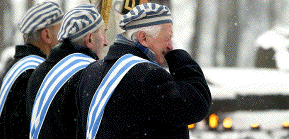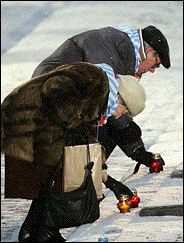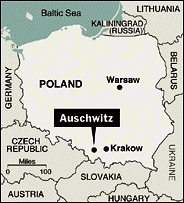Liberators and Survivors
Recall the Auschwitz That Was
 
|
|
Survivors,
along with world leaders and
liberators, gathered yesterday to mark
the day 60 years ago when the Red Army
freed the Auschwitz death
camp.
[Photo:Katarina
Stoltz/Reuters]
|
By
CRAIG S. SMITH
Published: January 28, 2005
AUSCHWITZ-BIRKENAU,
Poland, Jan. 27 -- Genry Koptev Gomolov was just
18 when he first saw this place, on Jan. 27,
1945. He had been drafted into the Red Army two
years earlier and was making his way on foot
across the Polish countryside with the remains
of his battalion when they stumbled upon the
Nazis' largest death camp.
"It was
cold and gloomy with wet snow falling, like
now," Mr. Gomolov said, riding a bus toward the
camp for his first visit there in 60 years. He
and two other former Red Army soldiers were
guests of honor at a ceremony here Thursday
marking the anniversary of the camp's
liberation.
Officials
from more than 30 countries gathered for the
commemoration and called again for the world to
"never forget" the horrors of the Holocaust, but
it was recollections by the ever-dwindling
number of witnesses that gave the day
meaning.
"We saw
the barbed wire and we understood it was a
camp," Mr. Gomolov said, lifting a finger at a
line of concrete posts studded with insulators
and still strung with wire.
He
recalled that once inside the camp he and his
comrades found thousands of wraithlike people
laughing and crying, singing and shouting, or
simply staring dumbly at their liberators. He
saw corpses stacked like cordwood and abandoned
before the Nazis could set them on fire. He saw
the crematories and the subterranean rooms he
later learned were gas chambers.
"It
made a deep impression," he said quietly, thick
bifocals magnifying his eyes. He eased down from
the bus and into the snow.
Thursday's
cold penetrated the overcoats of the people
gathered for the ceremony. It seeped into shoes,
burned toes and turned hands raw. The discomfort
only lasted a couple of hours but it was a stark
indication of the suffering that inmates of this
camp endured, without relief, except through
death. Many people remarked on it.
|

|
..
|
|
Former
camp inmates placed candles on the
death camp memorial.
[Photo:
Jockel Finck /Associated
Press]
|
"In wintertime, the mortality was terrible,"
said Sigmund Sobolweski, 81, who spent four and
a half years in the camp.
Some
survivors remember a bar, slightly more than
three feet high, that SS officers used to
separate children who could work from those too
young to be useful. Those shorter were sent to
the gas chambers. Many children, survivors say,
sensed the danger and strained to reach above
the bar.
Most
people who arrived at the camp were sent to the
gas chambers within hours. Others, deemed fit
enough to work, were stripped, shaved and
tattooed with an identity number on their
arm.
Jozef
Drozdz wore the coarse blue and white cap from
his former prison uniform to the ceremony. He
was captured by the Nazis in 1940, and worked on
building the first phase of the Auschwitz
complex before being moved through eight more
camps. "The Nazis knocked my teeth out," he
said, flashing his dentures in an even
smile.
The
ceremony began with the haunting sounds of train
whistles, evoking the arrival of prisoners on a
railroad that still runs deep into the camp and
was lined Thursday with candles.
The
presidents of Russia, Poland and Israel along
with several camp survivors spoke to the
assembled crowd, repeating the need to keep
awareness of the Holocaust alive after the last
survivors have died.
|
..
|

|
|
|
About
1.5 million people were killed at the
Auschwitz complex.
[Photo:
NY Times]
|
Simone Veil, a French lawmaker, spoke on behalf
of Jewish victims, a million of whom died in the
camp. Wladyslaw Bartoszewski, a former Polish
foreign minister who was interned in the camp,
spoke on behalf of Polish victims. Romani Rose,
from Germany's Council of Romas, spoke for
European Gypsies who were also interned and
killed there.
The
Russian president, Vladimir V. Putin,
representing the liberators of Auschwitz, used
the occasion to warn against compromising with
terrorists. He has been criticized for his
country's war against Islamic separatists in
Chechnya, which has spawned a singularly violent
movement. He said the Holocaust showed that just
"as there were no 'good' and 'bad' fascists,
there cannot be 'good' and 'bad'
terrorists."
"We
shall not only remember the past but also be
aware of all the threats of the modern world,"
he said. "Terrorism is among them and it is no
less dangerous and cunning than
fascism."
President
Moshe Katsav of Israel said at an earlier event
that the allies "did not do enough" to prevent
the killing of Jews in World War II and called
upon the European Union "not to allow Nazism to
live in the imagination of the youth of Europe
like some kind of horror show."
Vice
President Dick Cheney, speaking at the earlier
event, said, "The story of the camps reminds us
that evil is real and must be called by its name
and confronted."
But the
comments underscored an important difference
between the anti-Semitism of the 1930's that led
to the Holocaust and that appearing more
recently: while many governments across Europe
approved or at least tolerated anti-Semitism
then, it is uniformly condemned
today.
Of all
Thursday's speakers, the most impassioned was
Merka Shevach, anelderly woman from Bialystok,
Poland, who now lives in Israel. She took the
microphone to give an unscheduled, impromptu
speech as dusk fell.
"I was
here naked as a young girl, I was 16," Ms.
Shevach shouted to the crowd. "They brought my
family here and burnt them, they stole my name
and gave me a number."
She
pulled back her sleeve to show the tattoo:
15755.
"Now,"
she said, "I have a country, I have an army, I
have a president, I have a flag and this will
never happen again."
As the
ceremony ended, world leaders placed candles on
a memorial set between the ruins of two
crematories. A dozen thin spotlights reached
into the sky, catching snowflakes in their
beams. Other spotlights, mounted in the guard
towers, swept the snowy fields.
Finally,
a locomotive whistle blared and the train tracks
leading from the front gate to the crematories
were set ablaze to form two flaming lines
through the snow.
.
|